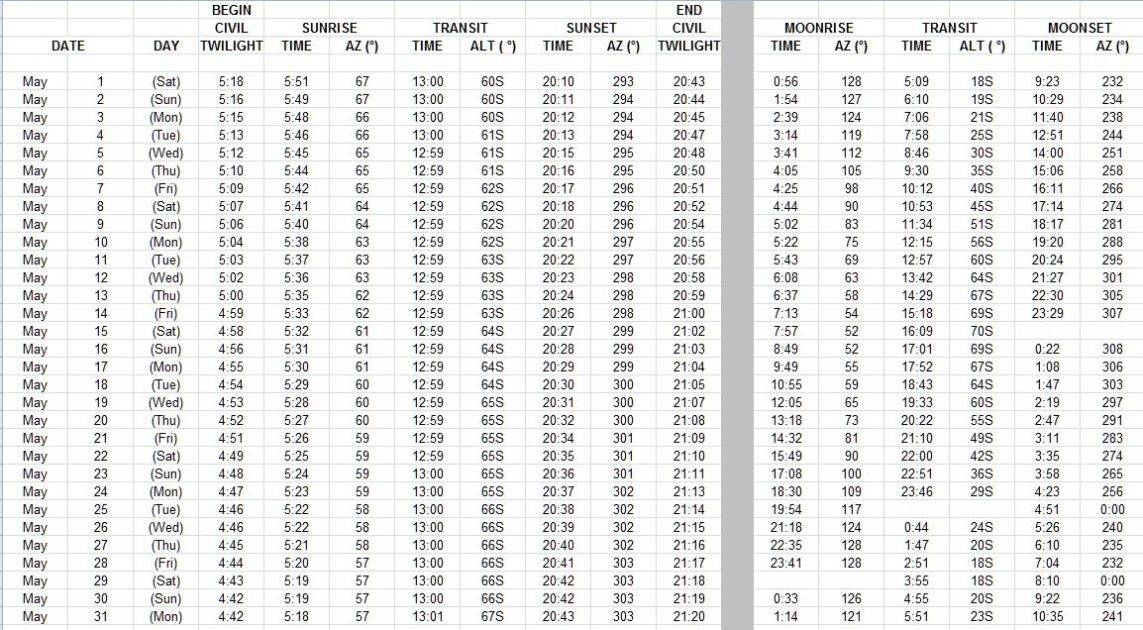These are closer celestial objects than the distant galaxies, and they are generally brighter and more accessible to our unaided eyes or small binoculars. You can search their names online to get directions on where to look. Seeing these objects—such as the Beehive cluster in Cancer (M44), M3 in Canes Venatici, M5 in Serpens Caput, and the expansive Coma Berenices star cluster (Melotte 111)—with your own eyes is much more impactful than looking at a picture of them. I would like to point out the lunar eclipse that will occur at dawn on Wednesday, May 26. But this comes with a warning: It will not be very impressive, since the brightening twilight will wash away much of its visual appeal.
NOTABLE EVENTSMay 3 Last-quarter moon
May 4 Mercury 2.5 degrees to left of Pleiades 10 degrees up in SW at 9 p.m.
May 11 New moon; moon at maximum apogee (farthest from Earth this year) at 406,511km
May 14 Sun enters Taurus
May 17 Mercury max elongation (22 degrees – eve)
May 19 First-quarter moon
May 21 Cassiopeia (Schedar) on meridian under North Star
May 26 Full moon; lunar eclipse in morning (mid-eclipse at 07:19:53); moon at minimum perigee (closest to Earth this year) at 357,309 km
May 28 Mercury and Venus 1/2-deg apart in WNW 3-deg above horizon
May 31 Virgo (Spica) on meridian at 10 p.m.

Lunar Eclipses: May 26 and November 19, 2021
A lunar eclipse occurs when the moon orbits through Earth’s shadow. The penumbra phase is when Earth’s shadow progresses across the moon, and the umbra phase is when the moon is entirely within Earth’s shadow. The moon is then illuminated only by light passing through our atmosphere around Earth’s limb. Since red light doesn’t scatter as much as blue light, the lunar disc will take on a reddish or copper colour. Clouds around Earth’s limb will block this light and the moon may almost “disappear.”
There are two early morning total lunar eclipses visible from Canada this year—on May 26 and November 19—but the later one will be the most visible.
The May 26 lunar eclipse will be visible in both Western Canada and Central Canada during the early morning. In Quebec and Ontario, it begins during the brightening twilight, only to have the moon set with the rising sun. People in British Columbia will see at least the first half of the eclipse before twilight washes it away. In Atlantic Canada, the moon will have already set before the eclipse begins.
The November 19 eclipse is also an early morning event, but it is better placed for most of the country. In the Maritimes, the final phase of the eclipse will be cut short by twilight and the setting moon.
The times of the May event are in eastern daylight time, while the November eclipse times are in eastern standard time.
For your city, you need only apply your time zone correction and not the Ottawa Time Corrections table.
| Moon Enters Penumbra | Moon Enters Umbra | Mid-Eclipse | Moon Leaves Umbra | Moon Leaves Penumbra | |
| May 26 | 04:47:39 | 05:44:57 | 07:19:53 | 07:25:55 | 9:49:41 |
| November 19 | 01:02:09 | 02:18:41 | 04:04:06 | 05:47:04 | 07:03:38 |

Planetary Configurations
When at opposition, planets will appear on the opposite side of the sky from the sun—very roughly on the meridian at midnight.
A conjunction is when the planet has the same “longitude” as the sun. A superior conjunction is when the planet is on the other side of the sun, and an inferior conjunction is when it is between Earth and the sun. Only Mercury and Venus can be at inferior conjunction. Maximum elongation is when Mercury and Venus appear farthest from the sun in our sky. This occurs either in our morning eastern sky (morn) or our western evening sky (eve).
Do not apply the Ottawa Time Corrections to the times in this table.


| Brightest Stars | |||
| Star Name | Scientific Name | Distance (Light-Years) | Midnight Transit |
| Alkaid | Eta UMa | 101 | May 4 |
| Arcturus | Alpha BOO | 37 | May 11 |

One of Canada’s foremost writers and educators on astronomical topics, the Almanac has benefited from Robert’s expertise since its inception. Robert is passionate about reducing light pollution and promoting science literacy. He has been an astronomy instructor for our astronauts and he ensures that our section on sunrise and sunset, stargazing, and celestial events is so detailed and extensive it is almost like its own almanac.













